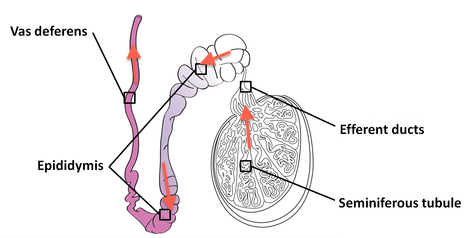|

CLICK ON weeks 0 - 40 and follow along every 2 weeks of fetal development
|
||||||||||||||||||||||||||||
|
Developmental biology - Male RNAs Small RNA in Sperm May Ensure Embryo Implants "Because of the rise in the use of assisted reproduction, it's vital to look at the differences between sperm removed directly from the testicles and those ejaculated, to investigate whether these differences may have an impact on the long-term health of the offspring." Past studies by Rando's and other labs suggest varying environmental conditions can affect sperm and the health of offspring. Lifestyle and exposure to hazardous toxins can induce stress which potentially affects levels and types of small RNA in sperm. In one study, Rando's lab investigated small RNA in sperm after the two week trip from the testis, through the epididymis, then the vas deferens, and exiting as ejaculate. They found ejaculate sperm undergo dramatic changes in the RNA. They also confirm that some RNA found in sperm actually originates in the epididymis, the highly convoluted duct leading to the vas deferens. This finding provides evidence for soma-to-germline transfer in male mammals.  Male mouse reproductive system showing sperm origination in testicle and 2 week passage to ejaculate. The second study looked at whether these small RNAs have any effect on sperm and thus on the zygote (or fertilized egg). Led by first author Colin C. Conine PhD, this team found that small RNAs in sperm are essential for normal pre-implantation development. Specifically, sperm taken from early in that 2 week trip, from the epididymis, exhibit dramatic misregulation in RNA and a variety of other epigenetic regulators. Used to fertilize eggs, this sperm resulted in failure of embryos to implant in the uterus. However, they also found these defects can be corrected by microinjecting small RNAs from the end of the epididymal path and into the newly formed embryo. "This research is vitally important because of the increasing use of assisted reproduction. A substantial subset of embryos are created using fertilization with testicular sperm - which has dramatically different RNA contents from ejaculated sperm. Highlights • Detailed characterization of small RNA dynamics in mammalian sperm maturation • Caput epididymosomes can deliver small RNAs to testicular spermatozoa in vitro • Metabolic labeling of RNAs in intact animals tracks RNAs from epididymis to sperm Summary The biogenesis of the RNA payload of mature sperm is of great interest, because RNAs delivered to the zygote at fertilization can affect early development. Here, we tested the hypothesis that small RNAs are trafficked to mammalian sperm during the process of post-testicular maturation in the epididymis. By characterizing small RNA dynamics during germ cell maturation in mice, we confirm and extend prior observations that sperm undergo a dramatic switch in the RNA payload from piRNAs to tRNA fragments (tRFs) upon exiting the testis and entering the epididymis. Small RNA delivery to sperm could be recapitulated in vitro by incubating testicular spermatozoa with caput epididymosomes. Finally, tissue-specific metabolic labeling of RNAs in intact mice definitively shows that mature sperm carry RNAs that were originally synthesized in the epididymal epithelium. These data demonstrate that soma-germline RNA transfer occurs in male mammals, most likely via vesicular transport from the epididymis to maturing sperm. Authors Upasna Sharma, Fengyun Sun, Colin C. Conine, Brian Reichholf, Shweta Kukreja, Veronika A. Herzog, Stefan L. Ameres, Oliver J. Rando. Return to top of page | Jul 31, 2018 Fetal Timeline Maternal Timeline News News Archive  Sperm collected for IVF is generally taken from the widest portion of the epididymis duct. But research reveals significant difference between RNA found in the epididymis and RNA from ejaculate. Image Credit: Mouseworks composite.
|
||||||||||||||||||||||||||||

